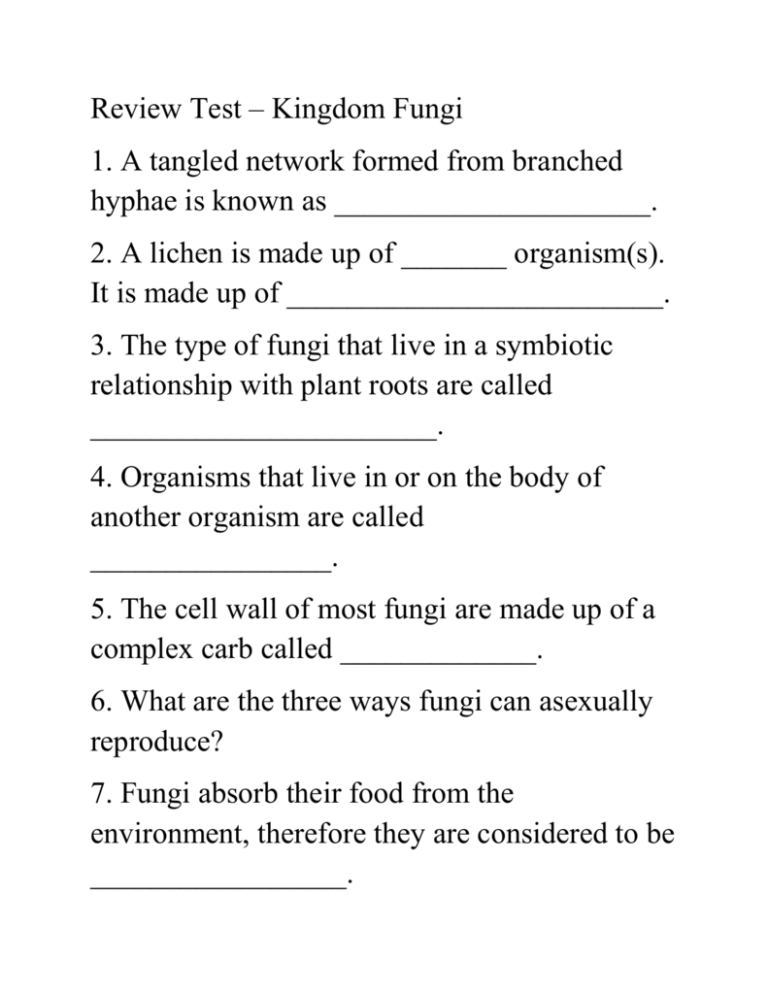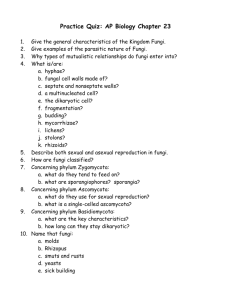Review Test - Kingdom Fungi
advertisement

Review Test – Kingdom Fungi 1. A tangled network formed from branched hyphae is known as _____________________. 2. A lichen is made up of _______ organism(s). It is made up of _________________________. 3. The type of fungi that live in a symbiotic relationship with plant roots are called _______________________. 4. Organisms that live in or on the body of another organism are called ________________. 5. The cell wall of most fungi are made up of a complex carb called _____________. 6. What are the three ways fungi can asexually reproduce? 7. Fungi absorb their food from the environment, therefore they are considered to be _________________. 8. Fungi most often feed on _________________. (think of our experiment in class). 9.List 2 defining characteristics of all fungi. 10. Some fungi have divisions in their hyphae, these are called _____________________. 11. List the four phyla of fungi with their common names. 12. The imperfect fungi differ from other fungi because_________________________. 13. Give an example of the Club Fungi. 14. Give an example of imperfect fungi. 15. What is the scientific name for bread mold? 16. What is the type of symbiosis where both individuals benefit? 17. What we recognize as a mushroom is actually the _____________ part of a fungus. 18. Name 2 ways fungal spores are spread. 19. Why can it be dangerous to have mold growing in your home? 20. The phylum Ascomycota is named for its ________ which is the reproductive structure containing the spores. 21. Name one disease/illness caused by fungus. 22. Truffles belong to which phylum of fungi? 23. Each hyphae of a fungi is ________ cell thick. 24. Bread mold has two types of hyphae ___________ and __________. 25. Distinguish between the terms hyphae and mycelium 26. What is the basis for classifying fungi? __________ and _______________. 27. Why do some fungal spores not germinate (ie grow into a new organism) Review Test – Kingdom Fungi 1. A tangled network formed from branched hyphae is known as mycelium. 2. A lichen is made up of two organism(s). It is made up of a fungus and green algae. 3. The type of fungi that live in a symbiotic relationship with plant roots are called mycorhhizae. 4. Organisms that live in or on the body of another organism are called parasites. 5. The cell wall of most fungi are made up of a complex carb called chitin. 6. What are the three ways fungi can asexually reproduce? Spores, fragmentation, budding 7. Fungi absorb their food from the environment, therefore they are considered to be heterotrophs. 8. Fungi most often feed on dead and decaying matter. (think of our experiment in class). 9.List 2 defining characteristics of all fungi. Eukaryotic, heterotrophic, reproduce asexually/sexually, have cell walls made of chitin, breakdown food outside of their cell wall 10. Some fungi have divisions in their hyphae, these are called crosswalls. 11. List the four phyla of fungi with their common names. Zygomycota – Common Molds Ascomycota – Sac Fungi Basidiomycota – Club Fungi Deuteromycota – Imperfect Fungi 12. The imperfect fungi differ from other fungi because no sexual reproduction has been observed in their life cycle. 13. Give an example of the Club Fungi. Mushrooms Truffles 14. Give an example of imperfect fungi. Penicillium, Aspergillus, Stachybotrys 15. What is the scientific name for bread mold? Zygomycota(phyla), Rhizopus (genus) stolonifer (species) 16. What is the type of symbiosis where both individuals benefit? Mutual symbiosis 17. What we recognize as a mushroom is actually the fruiting body part of a fungus. 18. Name 2 ways fungal spores are spread. Wind, animals, insects, humans, water 19. Why can it be dangerous to have mold growing in your home? Some molds produce toxins 20. The phylum Ascomycota is named for its ascus which is the reproductive structure containing the spores. 21. Name one disease/illness in humans caused by fungus. Ringworm, athletes foot, asthma, thrush, 22. Truffles belong to which phylum of fungi? Basidiomycota 23. Each hyphae of a fungi is one cell thick. 24. Bread mold has two types of hyphae rhizoids and stolons. 25. Distinguish between the terms hyphae and mycelium. Hyphae are thin filaments which make up the tangled mass of mycelium. 26. What is the basis for classifying fungi? structure and reproduction. 27. Why do some fungal spores not germinate (ie grow into a new organism) Fungi require specific conditions to grow. There must be proper combination of temperature, moisture and food.



